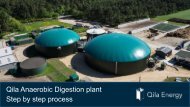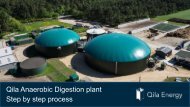Create successful ePaper yourself
Turn your PDF publications into a flip-book with our unique Google optimized e-Paper software.
The digester tank has four Mammut RF3 mixers from Paul Michl. The variable angle of the mixers is<br />
easily adjusted <strong>by</strong> a hydraulic unit, so the optimum positioning of the mixers can be controlled <strong>by</strong><br />
the operators who set the mixing pattern, which will depend on the exact characteristics of the<br />
substrate within the tank.<br />
The Mammut mixers have a 4.5m Shaft and a 1600mm propeller. These are highly efficient mixers,<br />
even when the dry substance content if high. The mixing provided is strong and slow, but also gentle<br />
which is well suited to operating in the digester tank. As the gear mechanism is outside the tank this<br />
allows for easy maintenance, as no electrical components are situated within the tank. The mixer is<br />
mounted with anti-vibration bearings which are fixed to an instillation bracket. This robust gear unit<br />
has low noise during operation. The drive shaft has multiple bearings and an oil-bath lubrication.<br />
• The biogas produced is mainly methane, (50% and 65%), Carbon dioxide (48%-33%) some water,<br />
Hydrogen sulphide and some other impurities in small quantities.<br />
• One of the impurities in the biogas is Hydrogen Sulphide (H 2 S), biological desulphurisation which<br />
removes this can be facilitated <strong>by</strong> injection of small amounts of oxygen, or air, into the tanks. This<br />
occurs as the oxygen encourages the growth of a certain type of bacteria, called thiobacilli, which<br />
occur on the surface of the digestate and as they grow and use the H 2 S in the biogas and leave a<br />
yellow clusters of sulphur on surface of the digestate. This process can also be performed in the<br />
storage tanks.





